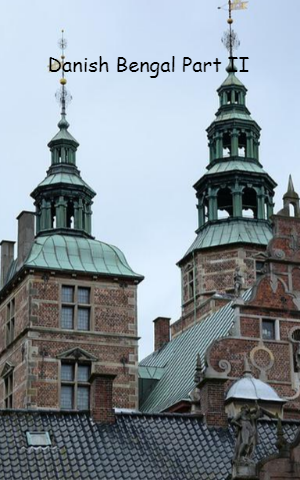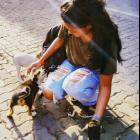Danish Bengal Part II
Danish Bengal Part II


Continuation from Danish Bengal Part 1
I reached Copenhagen at afternoon local time. I reset my watch three hours late than India. While collecting the luggage felt the environment of airport is open and trust based. A big label ‘Copenhagen’ written on the floor of airport welcomed us. It’s a airport cum railway station on below floors. As this was first time, one of my office colleague/friend came to take me. It was really privilege and honor when someone comes to airport when I travelled lone and its a new country.
Soon I met my friend at exit door was happy and relaxed. A big taxi (Mercedes) was standing in front of us, we just walked in. we started from Airport to my hotel which is mid way of Copenhagen Central and my office area. It was a warm day in Copenhagen with clear sky. I reached my hotel and settled down.
It was a office trip, and next few working days it used to be knowing the route and travelling to office and back to Hotel mostly. I used to travel by local bus, and train and Glostrup was nearest train station from my hotel. Morning when when I used to stand to catch my bus, it’s a peak time for office. But number of passengers in a stop maximum used to be two or three! Interesting this is every road there is a marked blue space entire path and that’s for cycle riders. Many office goers also rides gear based cycles, once they reach office change dress and so on. More amazing was in train, I saw compartments are marked/labeled with Cycle and many riders easily carry their cycles in those compartments. So there is blue marked paths all across the city and everyone respects these cycle riders.
Let me talk on food I enjoyed there. I used to take breakfast in the hotel, a varied types of breads, juices, fruits (few fruits are unique as Kiwi), sausage, milk ans so on. Definitely you can remember then luchi alu or hot dhosa in Indian any hotels. Generally Dansih food what I have seen is healthy, almost no spice and some people say some amount of raw meat also they take. Lunch in weekdays used to be office and that’s completely Danish food and subsidized. Lunch used to be wide variety of salads, with vegetables, green and fruits. Meat used to have lot of variety but because of some mental restrictions I used to only concentrate on if any chicken or fish. Preparation of chicken or sea fish (fish used to be rare) used to boiled type with very little spice. Milk and yogurt are something used to be there always. best part of Danish food is desserts, yummy Danish pastries with filling of apple or cream or cheese etc, croissant of different types, cakes and different types of bakery items.
while I was travelling by busses or trains, there is a continuous announcement system which happens in English and danish. After listening those announcements few days, I thought its easy to understand what they are saying in Danish. Danish words and pronunciation is completely different than English, as many alphabets remain silent. I spoke to one of my Danish collogue, he said me to keep trying but Danish is comparatively harder within scandavian languages. I kept my sincere try; even after coming India with online I tried to speak few words as language is my passion!
while staying in Denmark, history and few kings who rule Denmark while danes were in India were in my mind.
Christian VII (1749-1808) a young king, and his era is marked as ‘mental illness’. Due to health issues he was a nominal king and his haf brother Fredrck became regent. The progressive and radical thinker Johann Friedrich Struensee, Christian's personal physician, became his advisor and rose steadily in power in the late 1760s to de facto regent of the country, where he introduced widespread progressive reforms. During his time Danish flourished in Inida wrt trading and colony in Sreerampur.
Here after reaching that Frederiksnagore, first we went to Radhaballav jiu temple which is very famous and holds lots of history. There used to be zaminders Goswamis in Sreerampur. During 1757 timeframe Rudraram pandit who used to worship Krishna in ballavpur, around 2 km from sreerampur a forest type area, he saw a draeam that he wil get a stone from Gaur which to be made as Krishna’s idol. With lot of try he reached to Gaur and got the big stone (kastipathor- touchstone) but he was worried how to bring that to Ballavpur. Then he saw another dream of leaving that stone in Ganges and it will come. he did that and after reaching ballavput he found that stone also reached! within few years 1677 he made Krishna Radha idol and made the temple. Later years Nayanchand Mallick constructed the current structure of the temple. Currently temple is almost within residential areas, a quiet place. During Rasyatra, a big celebration happens. It’s a beautiful Krishna idol and a long flute is amazing. we took Radhabalav’s blessings to start our visit.
Sreerampur is a town on bank of Ganges, other side of the river is Barrackpur. Sreerampur as a city is s small, around a lakh of people stay here, where 72% literacy rate. This place has local Textile industries here, state government offices and many people goes to Kolkata for services. Sreerampur is a city now of Hoogly district of Westbengal, this district has cities as Chinsura Sadar, Serampore, Chandannagar, and Arambag. while head office in Chincurah. Its so interesting that all these cities are along the Ganges way and Dutch colony was in Chinchurah, French colony was in Chandannagar. And all European countries came here for trading spices, textiles and so on. As we see the town now is a normal city life, with some high rise building and on. While we visisted the Ganges ghats, we walked along the river sometime. Infrastructure, Crowd and quality of life of people who live there needs a huge improvements.
A big attraction here is Mahesh Rath. Its in 14th Century, a sage Dhrubananda Brahamachari went to Puri temple where he wanted to feed Lord Jagannath with his own hands. He got resistances from temple people but he waited couple of days there. Then he saw a dream of Lord Jagannath who said him to go back to Bengal, Mahesh village and he would get a Daru Brahma (Neem tree trunk) in the river Ganges. Dhrubananda returned to Sreerampur, where in Mahesh village he found that same Neem trunk from ganges. He made the idol of Lord Jagannath, Balaram and Suvadra and started worshipping the same. When Vaishnab guru Shri Shri Chaitanyadeb was going to Puri after his sanyas he came to Mahesh. He named this place as Naba Nilachal (Bew Puri). Later old Drubananda requested him to take charge of the temple. On his request he made Kamalakar Piplai, the fifth of his twelve Gopalas, the sebait of the temple. After few days Dhrubananda died. This Mahesh Rath which is very colorful made, long ago this Rath was made by wood and couple of time Rath was burnt. The present ratha or the chariot was constructed under the patronage of Krishnaram Basu by the Martin Burn Company in 1885. The cost of the construction was two million rupees. The ratha is a Nabaratna temple having nine shikharas. The ratha has a steel framework with wooden scaffolding. It is fitted with twelve iron wheels each measuring twelve inches in circumference. The ratha is four storied, measuring 50 feet in height and 125 tonnes in weight. Two copper horses are attached to the front. From 1396 Rathyatra celebration happens here and very famous as largest Rath festival within Bengal. We saw this famous beautiful Rath was standing beside the main road, and while we entered the temple, a big reconstruction was happening. It’s a same Lord Jagannath dev we took blessing and wished onetime to come during rathayatra.
As I said earlier in my mind this travel in Sreerampur I was thinking of Denmark Capital Copenhagen, and if any footprint or structure of houses can be seen. We decided to go to city side and moved towards Sreerampur College and Olav Church.





























































